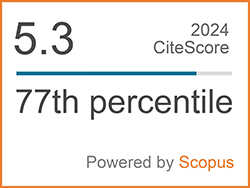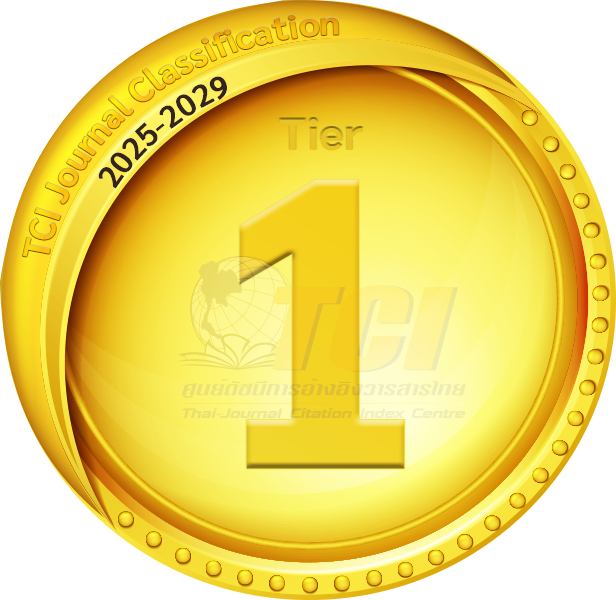Enhanced Biomass Productivity and β-cryptoxanthin Content of Chlorococcum sp. through Optimization Via Central Composite Design (CCD)
Abstract
Keywords
[1] M. Nakamura and M. Sugiura, “Health effects of β-cryptoxanthin and β-cryptoxanthin-enriched satsuma mandarin juice,” Nutrients in Beverages, pp. 393–417, Jan. 2019, doi: 10.1016/B978-0-12-816842-4.00011-3.
[2] C. H. Zhu, E. R. Gertz, Y. Cai, and B. J. Burri, “Consumption of canned citrus fruit meals increases human plasma β-cryptoxanthin concentration, whereas lycopene and β-carotene concentrations did not change in healthy adults,” Nutrition Research, vol. 36, pp. 679–688, Jul. 2016, doi: 10.1016/j.nutres.2016.03.005.
[3] H. Sun, Y. Wang, Y. He, B. Liu, H. Mou, F. Chen, and S. Yang, “Microalgae-derived pigments for the food industry,” Marine Drugs, vol. 21, p. 82, Jan. 2023, doi: 10.3390/md 21020082.
[4] A. Bunea, C. Socaciu, and A. Pintea, “Xanthophyll esters in fruits and vegetables,” Notulae Botanicae Horti Agrobotanici Cluj-Napoca, vol. 42, pp. 310–324, Dec. 2014, doi: 10.15835/nbha4229700.
[5] K. Takayanagi and K. Mukai, “Beta-cryptoxanthin, a novel carotenoid derived from Satsuma Mandarin, prevents abdominal obesity,” Nutrition in the Prevention and Treatment of Abdominal Obesity, pp. 381–399, Mar. 2014, doi: 10.1016/B978-0-12-407869-7.00034-9.
[6] R. K. Saini, S. H. Nile, and S. W. Park, “Carotenoids from fruits and vegetables: chemistry, analysis, occurrence, bioavailability and biological activities,” Food Research International, vol. 76, pp. 735–750, Oct. 2015, doi: 10.1016/j.foodres.2015.07.047.
[7] B. J. Burri, M. R. L. Frano, and C. Zhu, “Absorption, metabolism, and functions of β-cryptoxanthin,” Nutrition Reviews, vol. 74, pp. 69–82, Feb. 2016, doi: 10.1093/nutrit/nuv064.
[8] Y. Jiao, L. Reuss, and Y. Wang, “β-Cryptoxanthin: Chemistry, occurrence, and potential health benefits,” Current Pharmacology Reports, vol. 5, pp. 20–34, Feb. 2019, doi: 10.1007/s40495-019-00168-7.
[9] Y. Ren, H. Sun, J. Deng, J. Huang, and F. Chen, “Carotenoid production from microalgae: Biosynthesis, salinity responses and novel biotechnologies,” Marine Drugs, vol. 19, p. 713, Dec. 2021, doi: 10.3390/md19120713.
[10] P. Sirohi, H. Verma, S. K. Singh, V. K. Singh, J. Pandey, S. Khusharia, D. Kumar, Kaushalendra, P. Teotia, and A. Kumar, “Microalgal carotenoids: Therapeutic application and latest approaches to enhance the production,” Current Issues in Molecular Biology, vol. 44, pp. 6257–6279, Dec. 2022, doi: 10.3390/cimb44120427.
[11] C. Aflalo, Y. Meshulam, A. Zarka, and S. Boussiba, “On the relative efficiency of two‐vs. one‐stage production of astaxanthin by the green alga Haematococcus pluvialis,” Biotechnology and Bioengineering, vol. 98, pp. 300–305, Sep. 2007, doi: 10.1002/bit.21391.
[12] P. P. Lamers, C. C. van de Laak, P. S. Kaasenbrood, J. Lorier, M. Janssen, R. C. De Vos, R. J. Bino, and R. H. Wijffels, “Carotenoid and fatty acid metabolism in light‐stressed Dunaliella salina,” Biotechnology and Bioengineering, vol. 106, pp. 638–648, Jul. 2010, doi: 10.1002/ bit.22725.
[13] Y. Xie, S. H. Ho, C. N. N. Chen, C. Y. Chen, I. S. Ng, K. J. Jing, J. S. Chang, and Y. Lu, “Phototrophic cultivation of a thermo-tolerant Desmodesmus sp. for lutein production: Effects of nitrate concentration, light intensity and fed-batch operation,” Bioresource Technology, vol. 144, pp. 435–444, Sep. 2013, doi: 10.1016/ j.biortech.2013.06.064.
[14] L. Wolf, T. Cummings, K. Müller, M. Reppke, M. Volkmar, and D. Weuster‐Botz, “Production of β‐carotene with Dunaliella salina CCAP19/18 at physically simulated outdoor conditions,” Engineering in Life Sciences, vol. 21, pp. 115–125, Mar. 2021, doi: 10.1002/elsc.202000044.
[15] M. Kholany, J. A. Coutinho, and S. P. Ventura, “Carotenoid production from microalgae: The portuguese scenario,” Molecules, vol. 27, p. 2540, Apr. 2022, doi: 10.3390/molecules27082540.
[16] S. Mohamadnia, O. Tavakoli, and M. A. Faramarzi, “Enhancing production of fucoxanthin by the optimization of culture media of the microalga Tisochrysis lutea,” Aquaculture, vol. 533, Feb. 2021, Art. no. 736074, doi: 10.1016/j.aquaculture.2020.736074.
[17] S. Mohamadnia, O. Tavakoli, and M. A. Faramarzi, “Optimization of metabolic intermediates to enhance the production of fucoxanthin from Tisochrysis lutea,” Journal of Applied Phycology, vol. 34, pp. 1269–1279, Jun. 2022, doi: 10.1007/s10811-022-02717-y.
[18] K. Laje, M. Seger, B. Dungan, P. Cooke, J. Polle, and F. O. Holguin, “Phytoene accumulation in the novel microalga Chlorococcum sp. using the pigment synthesis inhibitor fluridone,” Marine Drugs, vol. 17, p. 187, Mar. 2019, doi: 10.3390/ md17030187.
[19] T. Mathimani, E. R. Rene, S. Devanesan, M. S. AlSalhi, and R. Shanmuganathan, “Assessment of taxonomically diverse Chlorococcum species and Chroococcus species for cell density, pigments, biochemical components, and fatty acid composition for fuel/food applications,” Algal Research, vol. 74, Jul. 2023, Art. no. 103228, doi: 10.1016/j.algal.2023.103228.
[20] F. E. Babadi, P. Boonnoun, K. Nootong, S. Powtongsook, M. Goto, and A. Shotipruk, “Identification of carotenoids and chlorophylls from green algae Chlorococcum humicola and extraction by liquefied dimethyl ether,” Food and Bioproducts Processing, vol. 123, pp. 296–303, Sep. 2020, doi: 10.1016/j.fbp.2020.07.008.
[21] T. Conde, D. Couto, T. Melo, A. S. Moreira, P. Ferreira, M. Costa, J. Silva, B. Neves, P. Domingues, and M. R. Domingues, “Production of a food grade extract of Chlorococcum amblystomatis rich in omega-3 lipids using ethanol assisted with ultrasound and deep characterization by lipidomics,” Journal of Applied Phycology, vol. 34, pp. 3011–3024, Dec. 2022, doi: 10.1007/s10811-022-02820-0.
[22] S. Chuechomsuk, B. Thumthanaruk, W. Kunyalung, S. Mohamadnia, I. Angelidaki, and V. Rungsardthong, “Production of β-cryptoxanthin at different artificial light spectra by three strains of microalgae,” Journal of Current Science and Technology, vol. 15, p. 107. Apr. 2025, doi: 10.59796/jcst.V15N2.2025.107.
[23] S. Chuechomsuk, B. Thumthanaruk, W. Kunyalung, S. Mohamadnia, I. Angelidaki, V. Rungsardthong, “Enhancement of β-cryptoxanthin production in three different green microalgae species using an innovative red LED wavelength shift approach,” Applied Science and Engineering Progress, 2025, Art. no. 7707, doi : 10.14416/j.asep.2025.03.001.
[24] R. Mitra, A. K. Samanta, S. Chaudhuri, and D. Dutta, “Impact of carbon source on β-cryptoxanthin production by Kocuria marina DAGII: a classical approach,” Materials Today: Proceedings, vol. 3, pp. 3269–3275, Jan. 2016, doi: 10.1016/j.matpr.2016.10.008.
[25] Y. Fukaya, M. Takemura, T. Koyanagi, T. Maoka, K. Shindo, and N. Misawa, “Structural and functional analysis of the carotenoid biosynthesis genes of a Pseudomonas strain isolated from the excrement of Autumn Darter,” Bioscience, Biotechnology, and Biochemistry, vol. 82, pp. 1043–1052. Jun. 20118, doi: 0.1080/09168451.2017.1398069.
[26] S. Korkerd, S. Vatanyoopaisarn, W. Visessaguan, B. Thumthanarak, D. Uttapap, S. I. Mussatto, and V. Rungsardthong, “Screening, identification, and characterization of high potential bacteria for β-cryptoxanthin production from natural sources,” Biocatalysis and Agricultural Biotechnology, vol. 57, Apr. 2024, Art. no. 103089, doi: 10.1016/j.bcab.2024.103089.
[27] S. Korkerd, S. Vatanyoopaisarn, W. Visessanguan, B. Thumthanarak, C. L. Perez, V. Rungsardthong, and S. I. Mussatto, “Saccharification of carrot pomace and use as nutrient source for the production of ꞵ-cryptoxanthin by Pantoea anthophila FL1_IS5,” Biomass Conversion and Biorefinery, pp. 1–16, Dec. 2024, doi: 10.1007/s13399-024-06423-2.
[28] X .M. Sun, L. J. Ren, Q. Y. Zhao, X. J. Ji, and H. Huang, “Microalgae for the production of lipid and carotenoids: A review with focus on stress regulation and adaptation,” Biotechnology for Biofuels, vol. 11, pp. 1–16, Dec. 2018, doi: 10.1186/s13068-018-1275-9.
[29] J. Lacroux, J. Seira, E. Trably, N. Bernet, J.P. Steyer, and R. van Lis, “Mixotrophic growth of Chlorella sorokiniana on acetate and butyrate: Interplay between substrate, C:N ratio and pH,” Frontiers in Microbiology, vol. 12, Jul. 2021, Art. no. 703614, doi: 10.3389/fmicb.2021.703614.
[30] A. Khanra, S. Vasistha, S. Kumar, and M. P. Rai, “Cultivation of microalgae on unhydrolysed waste molasses syrup using mass cultivation strategy for improved biodiesel,” Biotech, vol. 11, pp. 1–14, Jun. 2021, doi: 10.1007/s13205-021-02823-7.
[31] C. Y. Chen, M. H. Lee, Y. K. Leong, J. S. Chang, and D. J. Lee, “Biodiesel production from heterotrophic oleaginous microalga Thraustochytrium sp. BM2 with enhanced lipid accumulation using crude glycerol as alternative carbon source,” Bioresource Technology, vol. 306, Jun. 2020, Art. no. 123113, doi: 10.1016/ j.biortech.2020.123113.
[32] J. Lv, F. Zhao, J. Feng, Q. Liu, F. Nan, X. Liu, and S. Xie, “Transcriptomic analysis reveals the mechanism on the response of Chlorococcum sp. GD to glucose concentration in mixotrophic cultivation,” Bioresource Technology, vol. 288, Sep. 2019, Art. no. 121568, doi: 10.1016/j. biortech.2019.121568.
[33] M. Nayak, W. I. Suh, Y. K. Chang, and B. Lee, “Exploration of two-stage cultivation strategies using nitrogen starvation to maximize the lipid productivity in Chlorella sp. HS2,” Bioresource Technology, vol. 276, pp. 110–118, Mar. 2019, doi: 10.1016/j.biortech.2018.12.111.
[34] T. Kutluk, N. Altin, U. Y. A. R. Başar, N. and Kapucu, “Effect of different nitrogen sources on the growth and lipid accumulation of Chlorella variabilisi,” Journal of Applied Biological Sciences, vol. 2, pp. 38–40, Aug. 2018.
[35] M. A. Fatini, E. M. Basri, and W. W. Maznah, “Effect of different nitrogen sources on cell growth and biochemical compositions of Chlorococcum sp. cultivated under laboratory conditions,” IOP Conference Series: Earth and Environmental Science, vol. 711, Mar. 2021, Art. no. 012010, doi: 10.1088/1755-1315/711/1/012010.
[36] H. K. Lichtenthaler and C. Buschmann, “Chlorophylls and carotenoids: measurement and characterization by UV‐VIS spectroscopy,” Current Protocols in Food Analytical Chemistry, vol. 1, 2001, doi: 10.1002/0471142913.faf0403s01.
[37] F. Mandelli, V. S. Miranda, E. Rodrigues, and A. Z. Mercadante, “Identification of carotenoids with high antioxidant capacity produced by extremophile microorganisms,” World Journal of Microbiology and Biotechnology, vol. 28, pp. 1781–1790, Apr. 2012, doi: 10.1007/s11274-011-0993-y.
[38] E. Papadopoulou, M. C. R. de Evgrafov, A. Kalea, P. Tsapekos, and I. Angelidaki, “Adaptive laboratory evolution to hypersaline conditions of lactic acid bacteria isolated from seaweed,” New Biotechnology, vol. 75, pp. 21–30, Jul. 2023, doi: 10.1016/j.nbt.2023.03.001.
[39] C. J. Watras, K. A. Morrison, J. L. Rubsam, P. C. Hanson, A. J. Watras, G. D. LaLiberte, and P. Milewski, “A temperature compensation method for chlorophyll and phycocyanin fluorescence sensors in freshwater,” Limnology and Oceanography: Methods, vol. 15, pp. 642–652, Jul. 2017, doi: 10.1002/lom3.10188.
[40] M. Albrecht, S. K. Roshan, L. Fuchs, U. Karsten, and R. Schumann, “Applicability and limitations of high-throughput algal growth rate measurements using in vivo fluorescence in microtiter plates,” Journal of Applied Phycology, vol. 34, pp. 2037–2049, Aug. 2022, doi: 10.1007/ s10811-022-02778-z.
[41] M. Schagerl, R. Siedler, E. Konopáčová, and S. S. Ali, “Estimating biomass and vitality of microalgae for monitoring cultures: A roadmap for reliable measurements,” Cells, vol. 11, p. 2455, Aug. 2022, doi: 10.3390/cells11152455.
[42] Y. Guo, Y. Chen, T.D. Searchinger, M. Zhou, D. Pan, J. Yang, L. Wu, Z. Cui, W. Zhang, F. Zhang, and L. Ma, “Air quality, nitrogen use efficiency and food security in China are improved by cost-effective agricultural nitrogen management,” Nature Food, vol. 1, pp. 648–658, Oct. 2020, doi: 10.1038/s43016-020-00162-z.
[43] H. Zhu, Z. Ye, Z. Xu, and L. Wei, “Transcriptomic analysis reveals the effect of urea on metabolism of Nannochloropsis oceanica,” Life (Basel), vol. 14, p. 797, Jun. 2024, doi: 10.3390/life14070797.
[44] O. Zayed, O . A. Hewedy, A. Abdelmoteleb, M. Ali, M. S. Youssef, A. F. Roumia, D. Seymour, and Z. C. Yuan, “Nitrogen journey in plants: From uptake to metabolism, stress response, and microbe interaction,” Biomolecules, vol. 13, p. 1443, Sep. 2023, doi: 10.3390/biom13101443.
[45] M. Carletti, E. Barbera, F. Filippini, and E. Sforza, “Effect of ammonium/nitrate ratio on microalgae continuous cultures: Species-specificity of nutrient uptake and modelling perspectives,” Journal of Water Process Engineering, vol. 58, Feb. 2024, Art. no. 104762, doi: 10.1016/j.jwpe.2023.104762.
[46] G. Salbitani and S. Carfagna, “Ammonium utilization in microalgae: A sustainable method for wastewater treatment,” Sustainability, vol. 13, p. 956, Jan. 2021, doi: 10.3390/su13020956.
[47] K. J. Erratt, I. F. Creed, and C. G. Trick, “Comparative effects of ammonium, nitrate and urea on growth and photosynthetic efficiency of three bloom‐forming cyanobacteria,” Freshwater Biology, vol. 63, pp. 626–638, Jul. 2018, https://doi.org/10.1111/fwb.13099.
[48] T. S. Chandra, R. S. Deepak, M. M. Kumar, S. Mukherji, V. S. Chauhan, R. Sarada, and S. N. Mudliar, “Evaluation of indigenous fresh water microalga Scenedesmus obtusus for feed and fuel applications: effect of carbon dioxide, light and nutrient sources on growth and biochemical characteristics,” Bioresource Technology, vol. 207, pp. 430–439, May 2016, doi: 10.1016/j. biortech.2016.01.044.
[49] R. A. Baihaqi and W. D. Pratama, “Feasibility study of utilization of palm oil mill effluent (POME) as a source for microalgae nutrients,” Journal of Emerging Science and Engineering, vol. 1, pp. 1–5, Sep. 2023, doi: 10.61435/jese. 2023.1.
[50] V. C. Liyanaarachchi, M. Premaratne, T. U. Ariyadasa, P. H. V. Nimarshana, and A. Malik, “Two-stage cultivation of microalgae for production of high-value compounds and biofuels,” Algal Research, vol. 57, Art. no. 102353, Jul. 2021, doi: 10.1016/j.algal.2021.102353.
[51] S. A. Razzak, K. Bahar, K. O. Islam, A. K. Haniffa, M. O. Faruque, S. Z. Hossain, and M. M. Hossain, “Microalgae cultivation in photobioreactors: Sustainable solutions for a greener future,” Green Chemical Engineering, vol. 5, pp. 418–439, Dec. 2024, doi: 10.1016/j.gce.2023.10.004.
[52] H. S. Yun, Y. S. Kim, and H. S. Yoon, “Effect of different cultivation modes (photoautotrophic, mixotrophic, and heterotrophic) on the growth of Chlorella sp. and biocompositions,” Frontiers in Bioengineering and Biotechnology, vol. 9, Dec. 2021, Art. no. 774143, doi: 10.3389/fbioe.2021. 774143.
[53] S. L. Pahl, D. M. Lewis, F. Chen, and K. D. King, “Heterotrophic growth and nutritional aspects of the diatom Cyclotella cryptica (Bacillariophyceae): Effect of some environmental factors,” Journal of Bioscience and Bioengineering, vol. 10, pp. 235–239, Mar. 2010, doi: 10.1016/j.jbiosc.2009.08.480.
[54] B. Gao, A. Chen, W. Zhang, A. Li, and C. Zhang, “Co-production of lipids, eicosapentaenoic acid, fucoxanthin, and chrysolaminarin by Phaeodactylum tricornutum cultured in a flat-plate photobioreactor under varying nitrogen conditions,” Journal of Ocean University of China, vol. 16. pp. 916–924, Oct. 2017, doi: 10.1007/s11802-017-3174-2.
[55] M. S. Sahin, M. I. Khazi, Z. Demirel, and M. C. Dalay, “Variation in growth, fucoxanthin, fatty acids profile and lipid content of marine diatoms Nitzschia sp. and Nanofrustulum shiloi in response to nitrogen and iron,” Biocatalysis and Agricultural Biotechnology, vol. 17, pp. 390–398, Jan. 2019, doi: 10.1016/j.bcab.2018.12.023.
[56] S. Jahan, J. Pruvost, M. Titica, G. Cogne, and H. Fallowfield, “Synergy between carbon sources and light in microalgal culture from the perspective of wastewater treatment in high-rate algal ponds,” Algal Research, vol. 79, Apr. 2024, Art. no. 103466, doi: 10.1016/j.algal.2024.103466.
[57] G. Licata, C. Galasso, F. P. Esposito, A. P. Piccionello, and V. Villanova, “Mixotrophy in marine microalgae to enhance their bioactivity,” Microorganisms, vol. 13, p. 338, Feb. 2025, doi: 10.3390/microorganisms13020338.
[58] G. C. Zittelli, R. Lauceri, C. Faraloni, A. M. S. Benavides, and G. Torzillo, “Valuable pigments from microalgae: Phycobiliproteins, primary carotenoids, and fucoxanthin,” Photochemical & Photobiological Sciences, vol. 22, pp. 1733–1789, Aug. 2023, doi: 10.1007/s43630-023-00407-3.
[59] I. Skifa, N. Chauchat, P. H. Cocquet, and Y. Le Guer, “Microalgae cultivation in raceway ponds: Advances, challenges, and hydrodynamic considerations,” EFB Bioeconomy Journal, vol. 13, Dec. 2024, Art. no. 100073, doi: 10.1016/j. bioeco.2024.100073.
[60] A. Marchese, S. Lima, A. Cosenza, F. Giambalvo, and F. Scargiali, “Effects of light quality adjustment in microalgal cultivation: Flashing light and wavelength shifts in photobioreactor design,” Processes, vol. 13, p. 1159, Apr. 2025, doi: 10.3390/pr130411.DOI: 10.14416/j.asep.2025.07.004
Refbacks
- There are currently no refbacks.
 Applied Science and Engineering Progress
Applied Science and Engineering Progress







